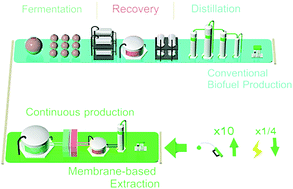Low energy intensity production of fuel-grade bio-butanol enabled by membrane-based extraction†
Abstract
Widespread use of biofuels is inhibited by the significant energy burden of recovering fuel products from aqueous fermentation systems. Here, we describe a membrane-based extraction (perstraction) system for the recovery of fuel-grade biobutanol from fermentation broths which can extract n-butanol with high purity (>99.5%) while using less than 25% of the energy of current technology options. This is achieved by combining a spray-coated thin-film composite membrane with 2-ethyl-1-hexanol as an extractant. The membrane successfully protects the micro-organisms from the extractant, which, although ideal in other respects, is a metabolic inhibitor. In contrast to water, the extractant does not form a heterogeneous azeotrope with n-butanol, and the overall energy consumption of for n-butanol production is 3.9 MJ kg−1, substantially less than other recovery processes (17.0–29.4 MJ kg−1). By (a) extracting n-butanol from the fermentation broth without a phase change, (b) breaking the heterogeneous azeotrope relationship (less energy consumption for distillation), and (c) utilizing a small volume ratio of extractant : fermentation broth (1 : 100, v/v), the need for high energy intensity processes such as pervaporation, gas stripping or liquid–liquid extraction is avoided. The application of this perstraction system to continuous production of a range of higher alcohols is explored and shown to be highly favourable.

- This article is part of the themed collection: Recent Open Access Articles


 Please wait while we load your content...
Please wait while we load your content...